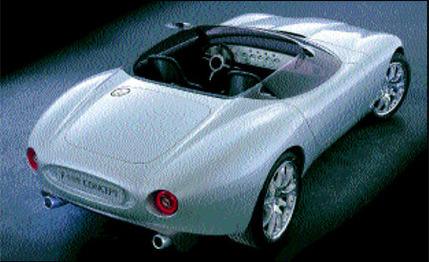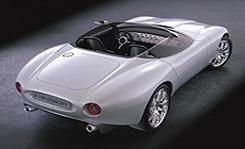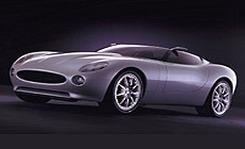
 First Drive Review
First Drive Review
Back in 1974, when the Jaguar E-type--we call it the XK-E in the U.S.--stopped production, it would have been reasonable to expect a successor called the F-type. But there wasn't one.
The British company that had made its reputation by winning the 24-hour race at Le Mans five times with the C-type and D-type sports racers had decided the world didn't want a tight-fitting two-seat sports car anymore, and that in the last quarter of the 20th century demand would be for a larger, more comfortable "grand tourer." That turned out to be the Jaguar XJS, which enjoyed a 20-year run until it was replaced by the current XK8.


But all along there were those at Jaguar who hankered for the return of an out-and-out sports roadster. In the 1980s, when Jaguar cut itself adrift from the stultifying influence of British Leyland, it began development of an F-type to succeed the XJS. That project, code-named XJ41, spun out of control, and by the time Ford acquired Jaguar for $1.6 billion in 1989, the F-type prototype was being described as "too heavy, too costly, and too late." Ford canceled it.
Curiously, the XJ41 project turned out to be the starting point for another car, the Aston Martin DB7--but that's another story. So it took Ford some years to sort out a future strategy for Jaguar. The XK8 has some of the E-type's styling, but it's really a tourer rather than a genuine sportster.
Then, in 1998, Jaguar surprised the world by unveiling the XK180 at the Paris auto show. A restyled and more racy XKR, the 180 was to demonstrate what an uncompromised high-performance Jaguar could be. The XK180 was never planned for production but refocused on the sports-car issue. "But if we are to introduce another sports car, it won't be like this," said the Jaguar brass. "It will need to be a smaller and cheaper car to compete with the Porsche Boxster."


Four years on, that prediction has come true. About the time you read this, Ford's top management in Dearborn is expected to sign off on the investment to produce the Jaguar F-type for the 2005 model year. It is the first Jaguar to be conceived under the aegis of the Premier Automotive Group and its German chairman, Wolfgang Reitzle, late of BMW. And it is designed to match the Boxster.
The Premier Automotive Group embraces Aston Martin as well as Jaguar. Aston needs to expand its product offering with a smaller and cheaper car than the DB7. The first thoughts were that the baby Aston and the new Jaguar roadster would share a platform or at least a majority of components. After all, Porsche had nearly 40-percent commonality between the Boxster and the 911.
Aston's project was a mid-engined, two-seat coupe to rival the Ferrari 360 Modena, but the inclination at Jaguar was toward a front-engined roadster that captured the spirit of the E-type. This design direction became clear when Jaguar went public with the F-type concept at the 2000 Detroit auto show. Small--13 inches shorter than an E-type and nine inches less than a Boxster--but beautifully proportioned, the F-type concept was the star of the show.
A year later in Los Angeles, Reitzle announced what was by then common knowledge: Jaguar would develop the F-type for production, and it would appear in 2004.
The F-type was unusual for a Jaguar concept car in not being a runner; indeed, as it was being prepped for display, no one really had an idea of what platform or power unit it might use. Its architect was Keith Helfet, who worked alongside the late Geoff Lawson, Jaguar's longtime styling boss. In many respects it was a scaled-down XK180, for which Helfet was also responsible.
Lawson's successor, Ian Callum, was the man who was renowned for shaping the DB7 and who had already completed the design of the smaller, mid-engined Aston. There were second thoughts about that over in Newport Pagnell. Another German, Ulrich Bez, had been brought in to head Aston Martin, and his view was that these cars should preserve their essentially British character rather than mirror race cars, and that meant placing the engine at the front.